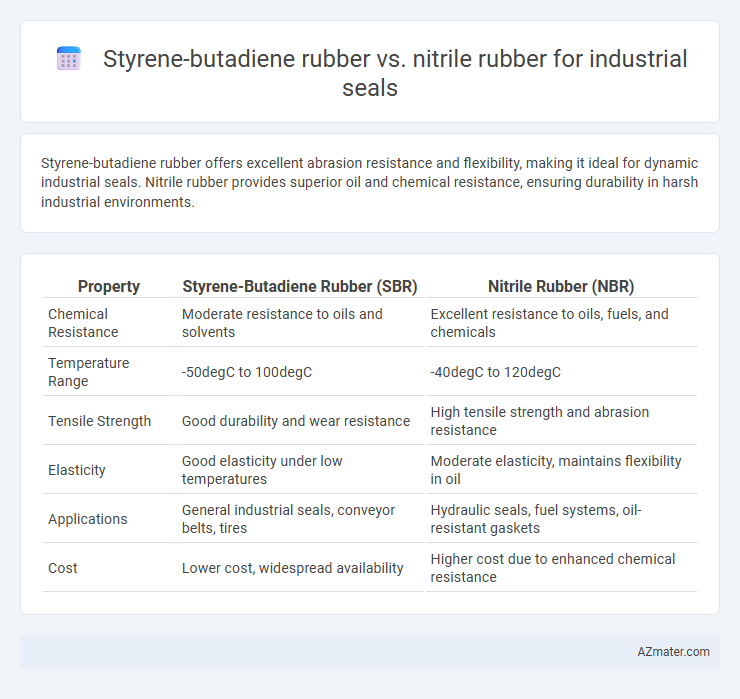Styrene-butadiene rubber offers excellent abrasion resistance and flexibility, making it ideal for dynamic industrial seals. Nitrile rubber provides superior oil and chemical resistance, ensuring durability in harsh industrial environments.
Table of Comparison
| Property | Styrene-Butadiene Rubber (SBR) | Nitrile Rubber (NBR) |
|---|---|---|
| Chemical Resistance | Moderate resistance to oils and solvents | Excellent resistance to oils, fuels, and chemicals |
| Temperature Range | -50degC to 100degC | -40degC to 120degC |
| Tensile Strength | Good durability and wear resistance | High tensile strength and abrasion resistance |
| Elasticity | Good elasticity under low temperatures | Moderate elasticity, maintains flexibility in oil |
| Applications | General industrial seals, conveyor belts, tires | Hydraulic seals, fuel systems, oil-resistant gaskets |
| Cost | Lower cost, widespread availability | Higher cost due to enhanced chemical resistance |
Overview of Styrene-Butadiene Rubber (SBR) and Nitrile Rubber (NBR)
Styrene-Butadiene Rubber (SBR) is a synthetic rubber known for its excellent abrasion resistance, aging stability, and cost-effectiveness, making it suitable for industrial seals exposed to mechanical wear. Nitrile Rubber (NBR) features superior oil and chemical resistance, especially against petroleum-based fluids, which enhances its performance in sealing applications involving fuels, oils, and solvents. Comparing both, SBR excels in general-purpose durability, while NBR offers enhanced resistance to hydrocarbons, making each rubber type optimal for specific industrial sealing environments.
Chemical Structure and Composition Differences
Styrene-butadiene rubber (SBR) consists of a copolymer of styrene and butadiene, providing a balance of toughness and abrasion resistance due to its saturated hydrocarbon backbone and aromatic styrene groups. Nitrile rubber (NBR) is a copolymer of acrylonitrile and butadiene, characterized by the presence of polar nitrile groups which enhance its resistance to oils, fuels, and chemicals. The key chemical structure difference lies in NBR's polar nitrile content, which significantly improves chemical resistance compared to the non-polar SBR, making NBR more suitable for industrial seals exposed to aggressive fluids.
Key Physical Properties Compared
Styrene-butadiene rubber (SBR) offers excellent abrasion resistance and flexibility, making it suitable for seals exposed to mechanical wear, while nitrile rubber (NBR) excels in oil, fuel, and chemical resistance, crucial for industrial seals in harsh chemical environments. SBR typically has a tensile strength of 15-25 MPa and elongation at break around 300-400%, whereas NBR provides higher tensile strength up to 25-30 MPa and elongation of approximately 400-600%, enhancing durability under pressure. NBR's superior resistance to swelling and degradation from petroleum-based fluids contrasts with SBR's better performance in dynamic applications requiring wear resistance and resilience.
Oil and Chemical Resistance Performance
Styrene-butadiene rubber (SBR) offers moderate oil resistance, making it suitable for seals exposed to light oils and non-aggressive chemicals; however, it degrades faster under prolonged hydrocarbon exposure compared to nitrile rubber (NBR). Nitrile rubber exhibits superior resistance to petroleum-based oils, fuels, and many industrial chemicals, providing enhanced durability and longevity in aggressive oil and chemical environments. For industrial seals requiring optimal performance against oils and harsh chemicals, nitrile rubber is preferred due to its resistance to swelling, cracking, and deformation.
Temperature Tolerance of SBR vs NBR
Styrene-butadiene rubber (SBR) typically withstands temperatures up to 70-100degC, making it suitable for moderate temperature industrial seals. Nitrile rubber (NBR) offers superior temperature tolerance, operating effectively between -40degC and 120degC, which enhances its performance in seals exposed to higher heat or temperature fluctuations. The broader temperature range and better thermal stability of NBR contribute to its preference for industrial applications requiring reliable sealing under diverse thermal conditions.
Mechanical Strength and Durability
Styrene-butadiene rubber (SBR) offers excellent abrasion resistance and good mechanical strength, making it suitable for industrial seals exposed to wear and tear. Nitrile rubber (NBR) provides superior oil and chemical resistance along with excellent tensile strength and durability under harsh conditions. While SBR excels in mechanical toughness, NBR outperforms in longevity and reliability when exposed to fuels, oils, and solvents in industrial sealing applications.
Industrial Applications: SBR and NBR Seals
Styrene-butadiene rubber (SBR) exhibits excellent abrasion resistance and is commonly used in industrial seals exposed to moderate temperatures and dry environments, making it ideal for conveyor belts and gaskets. Nitrile rubber (NBR) offers superior resistance to oils, fuels, and chemicals, which makes NBR seals highly effective in automotive, hydraulic, and petroleum-based applications. For industrial sealing solutions requiring durability against aggressive fluids, NBR seals outperform SBR seals due to their enhanced chemical resistance and temperature stability.
Cost-Effectiveness and Economic Considerations
Styrene-butadiene rubber (SBR) offers a lower initial cost compared to nitrile rubber (NBR), making it a cost-effective option for industrial seals in applications where oil resistance is not critical. Nitrile rubber, while generally more expensive, provides superior resistance to oils, fuels, and chemicals, which can reduce replacement frequency and maintenance expenses in demanding environments. Economic considerations should weigh upfront material costs against long-term durability and performance to determine the most cost-efficient choice for specific sealing applications.
Environmental and Safety Aspects
Styrene-butadiene rubber (SBR) and nitrile rubber (NBR) differ significantly in environmental and safety aspects, with SBR being less resistant to oils and chemicals, which can lead to faster degradation and potential environmental contamination in industrial seal applications. NBR offers superior chemical resistance, especially to petroleum-based fluids, reducing leak risks and enhancing workplace safety by minimizing hazardous exposure. Both materials are recyclable, but nitrile rubber's durability often results in longer service life and less frequent replacement, supporting sustainability goals in industrial settings.
Choosing the Right Rubber for Industrial Seals
Styrene-butadiene rubber (SBR) offers excellent abrasion resistance and good aging stability, making it ideal for industrial seals exposed to dry or mildly oily environments. Nitrile rubber (NBR) excels in oil, fuel, and chemical resistance, providing superior sealing performance in environments with frequent exposure to hydrocarbons. Selecting the right rubber depends on the specific media and temperature ranges involved, with SBR preferred for wear resistance and NBR for chemical compatibility in industrial sealing applications.

Infographic: Styrene-butadiene rubber vs Nitrile rubber for Industrial seal
 azmater.com
azmater.com